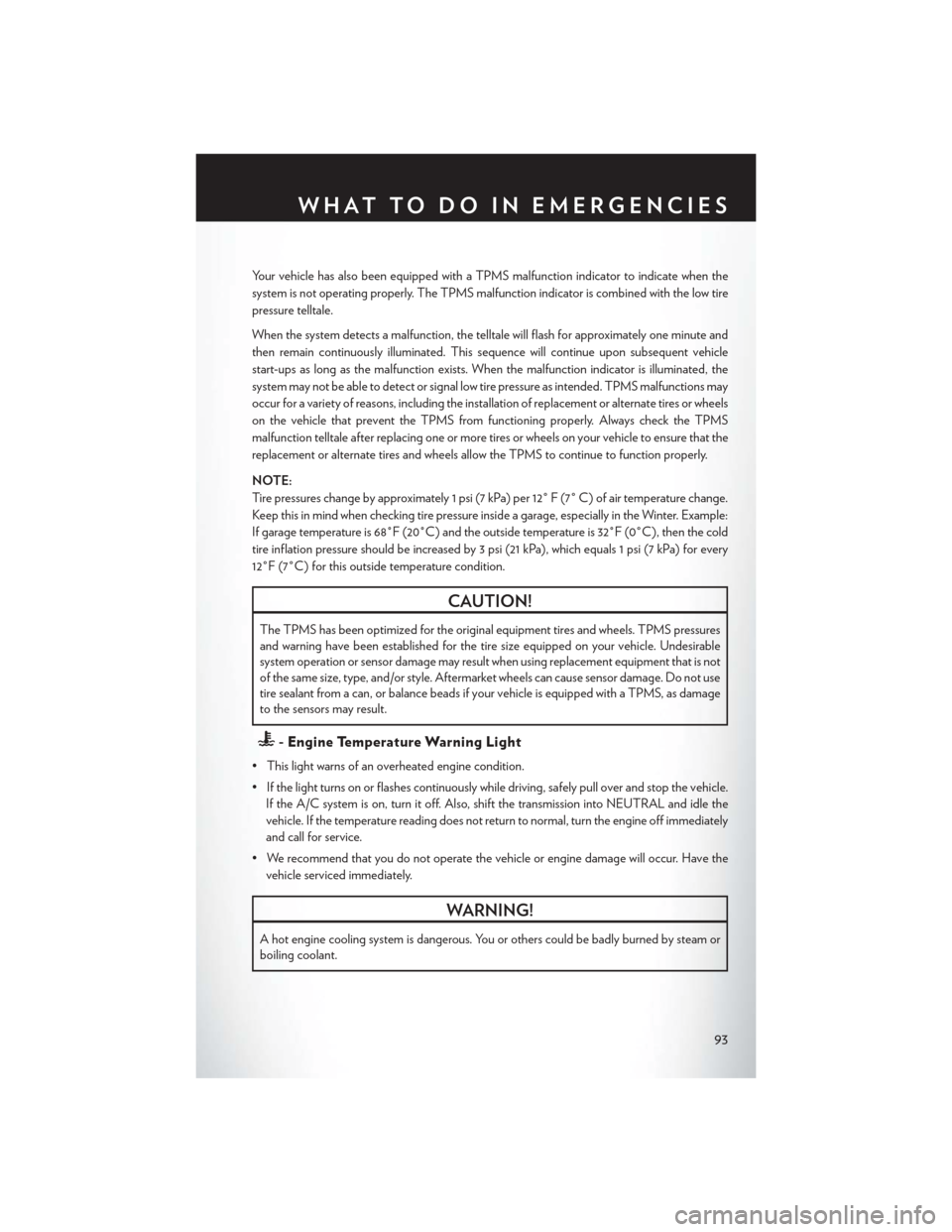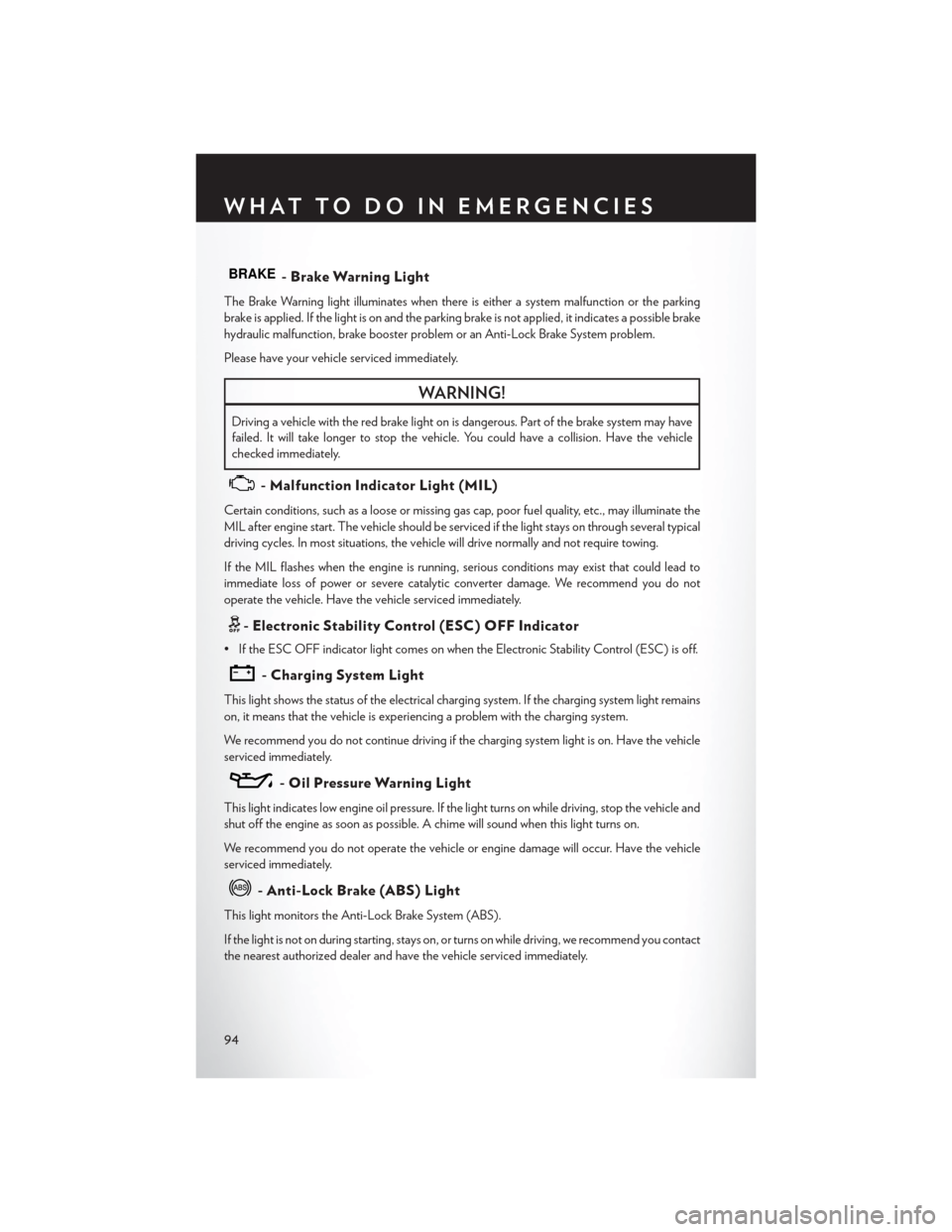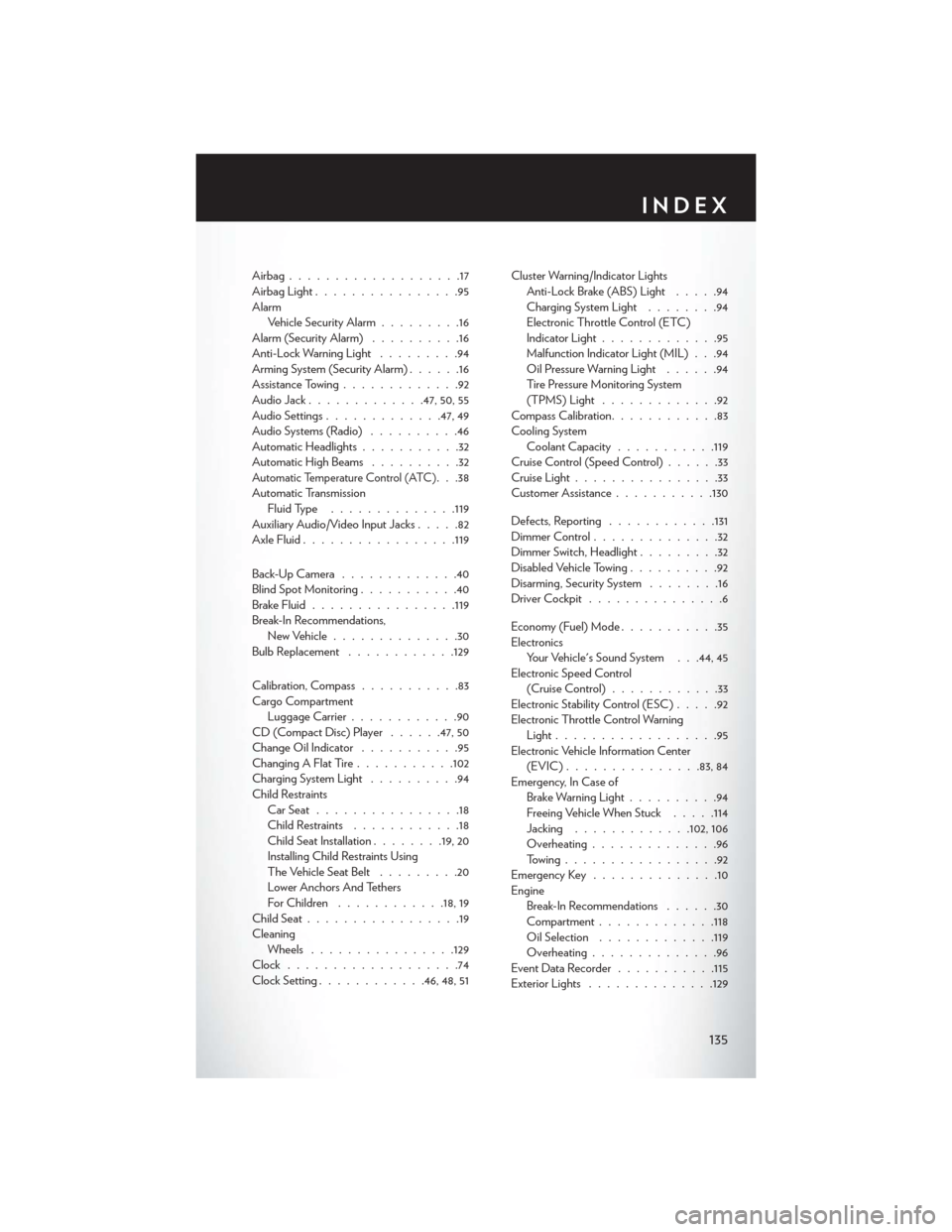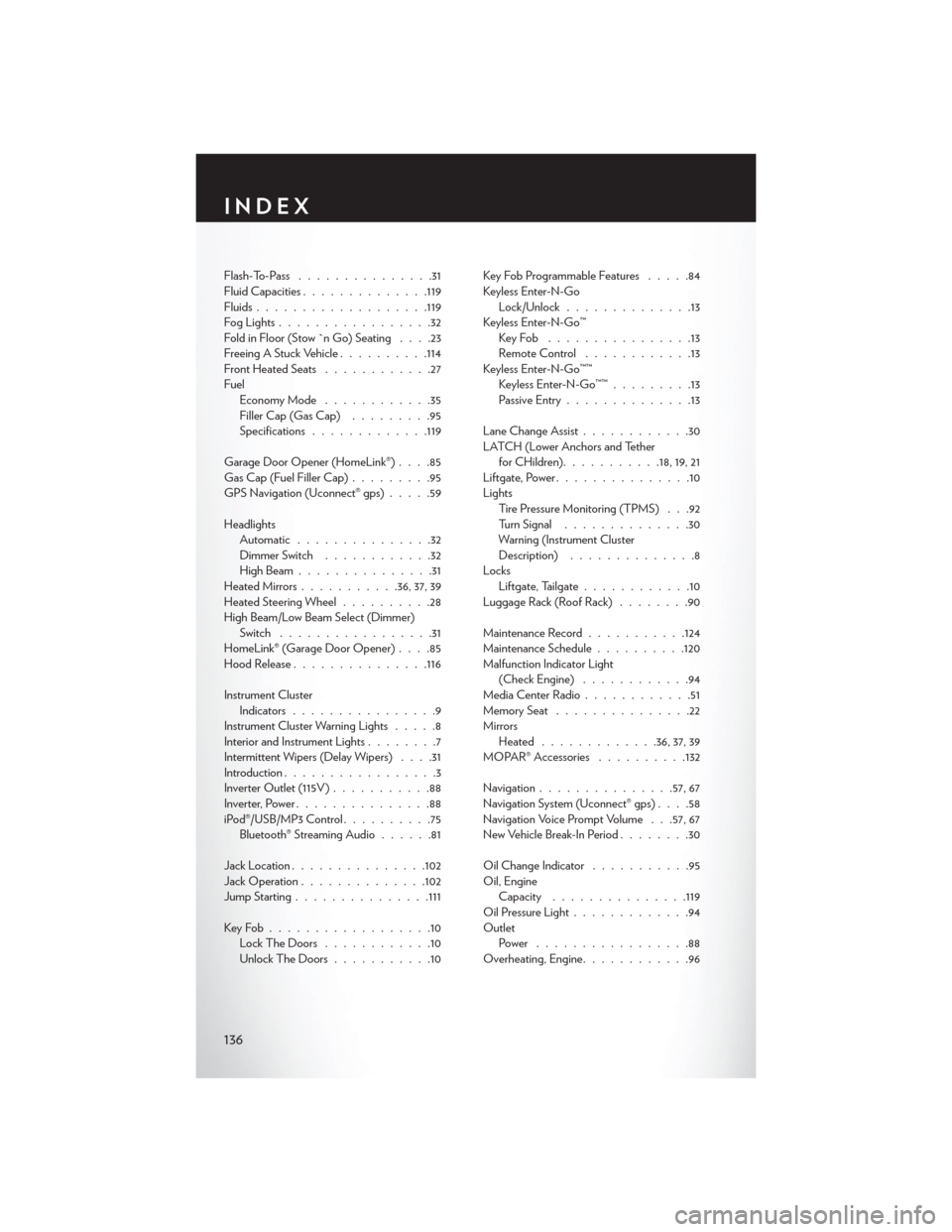oil pressure CHRYSLER TOWN AND COUNTRY 2014 5.G User Guide
[x] Cancel search | Manufacturer: CHRYSLER, Model Year: 2014, Model line: TOWN AND COUNTRY, Model: CHRYSLER TOWN AND COUNTRY 2014 5.GPages: 148, PDF Size: 4.26 MB
Page 10 of 148

INSTRUMENT CLUSTER
Warning Lights
- Low Fuel Warning Light
- Charging System Light
- Oil Pressure Warning Light
- Anti-Lock Brake (ABS) Light**
- Air Bag Warning Light**
- Electronic Throttle Control (ETC) Light
- Tire Pressure Monitoring System (TPMS) Light
- Engine Temperature Warning Light
- Seat Belt Reminder Light
BRAKE- Brake Warning Light**
- Malfunction Indicator Light (MIL)**
- Electronic Stability Control (ESC) Activation/Malfunction Indicator Light*
(See page 92 for more information.)
CONTROLS AT A GLANCE
8
Page 11 of 148

Indicators
- Turn Signal Indicators
- High Beam Indicator
- Front Fog Light Indicator
- Vehicle Security Indicator*
- Electronic Stability Control(ESC) Off Indicator*
- Electronic Speed Control ONIndicator
- Electronic Speed Control SetIndicator
Odometer Messages
door - Door Ajar noFUSE* - Fuse Fault
gASCAP - Fuel Cap Fault LoW tirE* - Low Tire Pressure
gATE* - Liftgate Ajar CHAngE OIL* - Change Engine Oil
LoCOOL - Low Coolant
* If equipped
** Bulb Check with Key On
CONTROLS AT A GLANCE
9
Page 95 of 148

Your vehicle has also been equipped with a TPMS malfunction indicator to indicate when the
system is not operating properly. The TPMS malfunction indicator is combined with the low tire
pressure telltale.
When the system detects a malfunction, the telltale will flash for approximately one minute and
then remain continuously illuminated. This sequence will continue upon subsequent vehicle
start-ups as long as the malfunction exists. When the malfunction indicator is illuminated, the
system may not be able to detect or signal low tire pressure as intended. TPMS malfunctions may
occur for a variety of reasons, including the installation of replacement or alternate tires or wheels
on the vehicle that prevent the TPMS from functioning properly. Always check the TPMS
malfunction telltale after replacing one or more tires or wheels on your vehicle to ensure that the
replacement or alternate tires and wheels allow the TPMS to continue to function properly.
NOTE:
Tire pressures change by approximately 1 psi (7 kPa) per 12° F (7° C) of air temperature change.
Keep this in mind when checking tire pressure inside a garage, especially in the Winter. Example:
If garage temperature is 68°F (20°C) and the outside temperature is 32°F (0°C), then the cold
tire inflation pressure should be increased by 3 psi (21 kPa), which equals 1 psi (7 kPa) for every
12°F (7°C) for this outside temperature condition.
CAUTION!
The TPMS has been optimized for the original equipment tires and wheels. TPMS pressures
and warning have been established for the tire size equipped on your vehicle. Undesirable
system operation or sensor damage may result when using replacement equipment that is not
of the same size, type, and/or style. Aftermarket wheels can cause sensor damage. Do not use
tire sealant from a can, or balance beads if your vehicle is equipped with a TPMS, as damage
to the sensors may result.
- Engine Temperature Warning Light
• This light warns of an overheated engine condition.
• If the light turns on or flashes continuously while driving, safely pull over and stop the vehicle.If the A/C system is on, turn it off. Also, shift the transmission into NEUTRAL and idle the
vehicle. If the temperature reading does not return to normal, turn the engine off immediately
and call for service.
• We recommend that you do not operate the vehicle or engine damage will occur. Have the vehicle serviced immediately.
WARNING!
A hot engine cooling system is dangerous. You or others could be badly burned by steam or
boiling coolant.
WHAT TO DO IN EMERGENCIES
93
Page 96 of 148

BRAKE- Brake Warning Light
The Brake Warning light illuminates when there is either a system malfunction or the parking
brake is applied. If the light is on and the parking brake is not applied, it indicates a possible brake
hydraulic malfunction, brake booster problem or an Anti-Lock Brake System problem.
Please have your vehicle serviced immediately.
WARNING!
Driving a vehicle with the red brake light on is dangerous. Part of the brake system may have
failed. It will take longer to stop the vehicle. You could have a collision. Have the vehicle
checked immediately.
- Malfunction Indicator Light (MIL)
Certain conditions, such as a loose or missing gas cap, poor fuel quality, etc., may illuminate the
MIL after engine start. The vehicle should be serviced if the light stays on through several typical
driving cycles. In most situations, the vehicle will drive normally and not require towing.
If the MIL flashes when the engine is running, serious conditions may exist that could lead to
immediate loss of power or severe catalytic converter damage. We recommend you do not
operate the vehicle. Have the vehicle serviced immediately.
- Electronic Stability Control (ESC) OFF Indicator
• If the ESC OFF indicator light comes on when the Electronic Stability Control (ESC) is off.
- Charging System Light
This light shows the status of the electrical charging system. If the charging system light remains
on, it means that the vehicle is experiencing a problem with the charging system.
We recommend you do not continue driving if the charging system light is on. Have the vehicle
serviced immediately.
- Oil Pressure Warning Light
This light indicates low engine oil pressure. If the light turns on while driving, stop the vehicle and
shut off the engine as soon as possible. A chime will sound when this light turns on.
We recommend you do not operate the vehicle or engine damage will occur. Have the vehicle
serviced immediately.
- Anti-Lock Brake (ABS) Light
This light monitors the Anti-Lock Brake System (ABS).
If the light is not on during starting, stays on, or turns on while driving, we recommend you contact
the nearest authorized dealer and have the vehicle serviced immediately.
WHAT TO DO IN EMERGENCIES
94
Page 101 of 148

NOTE:
If the Mode Select Knob (5) is on Air Mode and the pump is operating, air will dispense from the
Air Pump Hose (7) only, not the Sealant Hose (6).
If the sealant (white fluid) does flow through the Sealant Hose (6):
1. Continue to operate the pump until sealant is no longer flowing through the hose (typicallytakes 30 - 70 seconds). As the sealant flows through the Sealant Hose (6), the Pressure Gauge
(3) can read as high as 70 psi (4.8 Bar). The Pressure Gauge (3) will decrease quickly from
approximately 70 psi (4.8 Bar) to the actual tire pressure when the Sealant Bottle (1) is empty.
2. The pump will start to inject air into the tire immediately after the Sealant Bottle (1) is empty. Continue to operate the pump and inflate the tire to the pressure indicated on the tire pressure
label on the driver-side latch pillar (recommended pressure). Check the tire pressure by
looking at the Pressure Gauge (3).
If the tire does not inflate to at least 26 psi (1.8 Bar) pressure within 15 minutes:
The tire is too badly damaged. Do not attempt to drive the vehicle further. Call for assistance.
NOTE:
If the tire becomes over-inflated, press the Deflation Button to reduce the tire pressure to the
recommended inflation pressure before continuing.
If the tire inflates to the recommended pressure or is at least 26 psi (1.8 Bar) pressure within
15 minutes:
1. Press the Power Button (4) to turn off the TIREFIT kit.
2. Remove the Speed Limit sticker from the top of the Sealant Bottle (1) and place the sticker on the instrument panel.
3. Immediately disconnect the Sealant Hose (6) from the valve stem, reinstall the cap on the fitting at the end of the hose, and place the TIREFIT kit in the vehicle storage location.
Quickly proceed to (D) “Drive Vehicle.”
(D) Drive Vehicle:
Immediately after injecting sealant and inflating the tire, drive the vehicle 5 miles (8 km) or
10 minutes to ensure distribution of the TIREFIT Sealant within the tire. Do not exceed 55 mph
(88 km/h).
(E) After Driving:
Pull over to a safe location. Refer to “Whenever You Stop to Use TIREFIT” before continuing.
1. Turn the Mode Select Knob (5) to the Air Mode position.
2. Uncoil the Air Pump Hose (7) (black in color) and screw the fitting at the end of hose (7) onto the valve stem.
3. Uncoil the power plug and insert the plug into the vehicles 12 Volt power outlet.
4. Check the pressure in the tire by reading the Pressure Gauge (3).
WHAT TO DO IN EMERGENCIES
99
Page 102 of 148

If tire pressure is less than 19 psi (1.3 Bar), the tire is too badly damaged. Do not attempt to
drive the vehicle further. Call for assistance.
If the tire pressure is 19 psi (1.3 Bar) or higher:
1. Press the Power Button (4) to turn on TIREFIT and inflate the tire to the pressure indicated onthe tire and loading information label on the driver-side door opening.
2. Disconnect the TIREFIT kit from the valve stem, reinstall the cap on the valve stem and unplug from 12 Volt outlet.
3. Place the TIREFIT kit in its proper storage area in the vehicle.
4. Have the tire inspected and repaired or replaced at the earliest opportunity at an authorized dealer or tire service center.
5. Replace the Sealant Bottle (1) and Sealant Hose (6) assembly at your authorized dealer as soon as possible. Refer to “(F) Sealant Bottle and Hose Replacement.”
NOTE:
• If the tire becomes over-inflated, press the Deflation Button to reduce the tire pressure to the recommended inflation pressure before continuing.
• When having the tire serviced, advise the authorized dealer or service center that the tire has been sealed using the TIREFIT service kit.
(F) Sealant Bottle And Hose Replacement:
1. Uncoil the Sealant Hose (6) (clear in color).
2. Locate the round Sealant Bottle release button in the recessed area under the sealant bottle.
3. Press the Sealant Bottle release button. The Sealant Bottle (1) will pop up. Remove the bottle
and dispose of it accordingly.
4. Clean any remaining sealant from the TIREFIT housing.
5. Position the new Sealant Bottle (1) in the housing so that the Sealant Hose (6) aligns with the hose slot in the front of the housing. Press the bottle into the housing. An audible click will be
heard indicating the bottle is locked into place.
6. Verify that the cap is installed on the fitting at the end of the Sealant Hose (6) and return the hose to its storage area (located on the bottom of the air pump).
7. Return the TIREFIT kit to its storage location in the vehicle.
WHAT TO DO IN EMERGENCIES
100
Page 123 of 148

NOTE:
Under no circumstances should oil change intervals exceed 10,000 miles (16,000 km) or twelve
months, whichever comes first.
Severe Duty All Models
Change Engine Oil at 4000 miles (6,500 km) if the vehicle is operated in a dusty and off road
environment. This type of vehicle use is considered Severe Duty.
Once A Month Or Before A Long Trip:
• Check engine oil level.
• Check windshield washer fluid level.
• Check tire pressure and look for unusual wear or damage. Rotate tires at the first sign ofirregular wear, even if it occurs before the oil indicator system turns on.
• Check the fluid levels of the coolant reservoir, brake master cylinder, and power steering and fill as needed.
• Check function of all interior and exterior lights .
Required Maintenance Intervals.
Refer to the maintenance schedules on the following page for the required maintenance
intervals.
At Every Oil Change Interval As Indicated By Oil Change Indicator System:
• Change oil and filter.
• Rotate the tires. Rotate at the first sign of irregular wear, even if it occurs before the oil
indicator system turns on.
• Inspect battery and clean and tighten terminals as required.
• Inspect automatic transmission fluid if equipped with dipstick.
• Inspect brake pads, shoes, rotors, drums, hoses and park brake.
• Inspect engine cooling system protection and hoses.
• Inspect exhaust system.
• Inspect engine air cleaner if using in dusty or off-road conditions.
MAINTAINING YOUR VEHICLE
121
Page 136 of 148

UTILITY
• How do I know how much I can tow with my Chrysler Town & Country? pg. 91
WHAT TO DO IN EMERGENCIES
• What do I do if my TPMS warning light is blinking? pg. 92
• How do I change a flat tire? pg. 106
• How do I Jump-Start my vehicle? pg. 111
MAINTAINING YOUR VEHICLE
• Where is my Fuse Block located? pg. 126
• What type of oil do I use? pg. 119
• How often should I change my engine’s oil? pg. 120
• What should my tire pressure be set at? pg. Tire Pressures 128
FREQUENTLY ASKED QUESTIONS
134
Page 137 of 148

Airbag...................17
Airbag Light................95
Alarm Vehicle Security Alarm .........16
Alarm (Security Alarm) ..........16
Anti-Lock Warning Light .........94
Arming System (Security Alarm) ......16
Assistance Towing .............92
AudioJack.............47, 50, 55
Audio Settings .............47, 49
Audio Systems (Radio) ..........46
Automatic Headlights ...........32
Automatic High Beams ..........32
Automatic Temperature Control (ATC). . .38
Automatic Transmission Fluid Type ............. .119
Auxiliary Audio/Video Input Jacks .....82
Axle Fluid ................ .119
Back-UpCamera .............40
Blind Spot Monitoring ...........40
Brake Fluid ............... .119
Break-In Recommendations, New Vehicle ..............30
Bulb Replacement ............129
Calibration, Compass ...........83
Cargo Compartment Luggage Carrier ............90
CD (Compact Disc) Player ......47, 50
Change Oil Indicator ...........95
ChangingAFlatTire...........102
Charging System Light ..........94
Child Restraints CarSeat................18
Child Restraints ............18
Child Seat Installation ........19, 20
Installing Child Restraints Using
The Vehicle Seat Belt .........20
Lower Anchors And Tethers
For Children ............18, 19
ChildSeat.................19
Cleaning Wheels ............... .129
Clock ...................74
Clock Setting ............46, 48, 51 Cluster Warning/Indicator Lights
Anti-Lock Brake (ABS) Light .....94
Charging System Light ........94
Electronic Throttle Control (ETC)
Indicator Light .............95
Malfunction Indicator Light (MIL) . . .94
Oil Pressure Warning Light ......94
Tire Pressure Monitoring System
(TPMS) Light .............92
Compass Calibration ............83
Cooling System Coolant Capacity ...........119
Cruise Control (Speed Control) ......33
Cruise Light ................33
Customer Assistance ...........130
Defects, Reporting ............131
Dimmer Control ..............32
Dimmer Switch, Headlight .........32
Disabled Vehicle Towing ..........92
Disarming, Security System ........16
Driver Cockpit ...............6
Economy (Fuel) Mode ...........35
Electronics Your Vehicle's Sound System . . .44, 45
Electronic Speed Control (Cruise Control) ............33
Electronic Stability Control (ESC) .....92
Electronic Throttle Control Warning Light ..................
95
Electronic Vehicle Information Center (EVIC)...............83, 84
Emergency, In Case of Brake Warning Light ..........94
Freeing Vehicle When Stuck .....114
Jacking .............102,106
Overheating ..............96
Towing.................92
Emergency Key ..............10
Engine Break-In Recommendations ......30
Compartment ............ .118
Oil Selection .............119
Overheating ..............96
EventDataRecorder.......... .115
Exterior Lights ............. .129
INDEX
135
Page 138 of 148

Flash-To-Pass...............31
Fluid Capacities ............. .119
Fluids .................. .119
FogLights.................32
Fold in Floor (Stow `n Go) Seating ....23
Freeing A Stuck Vehicle ..........114
Front Heated Seats ............27
Fuel EconomyMode ............35
Filler Cap (Gas Cap) .........95
Specifications ............ .119
Garage Door Opener (HomeLink®) ....85
Gas Cap (Fuel Filler Cap) .........95
GPS Navigation (Uconnect® gps) .....59
Headlights Automatic ...............32
Dimmer Switch ............32
HighBeam...............31
Heated Mirrors ...........36, 37, 39
Heated Steering Wheel ..........28
High Beam/Low Beam Select (Dimmer) Switch .................31
HomeLink® (Garage Door Opener) ....85
Hood Release .............. .116
Instrument Cluster Indicators ................9
Instrument Cluster Warning Lights .....8
Interior and Instrument Lights ........7
Intermittent Wipers (Delay Wipers) ....31
Introduction .................3
Inverter Outlet (115V) ...........88
Inverter, Power ...............88
iPod®/USB/MP3 Control ..........75
Bluetooth® Streaming Audio ......81
Jack Location .............. .102
Jack Operation ............. .102
Jump Starting .............. .111
KeyFob..................10 LockTheDoors ............10
Unlock The Doors ...........10 Key Fob Programmable Features
.....84
Keyless Enter-N-Go Lock/Unlock ..............13
Keyless Enter-N-Go™ KeyFob ................13
RemoteControl ............13
Keyless Enter-N-Go™™ Keyless Enter-N-Go™™ .........13
Passive Entry ..............13
Lane Change Assist ............30
LATCH (Lower Anchors and Tether for CHildren) ...........18,19,21
Liftgate, Power ...............10
Lights Tire Pressure Monitoring (TPMS) . . .92
Turn Signal ..............30
Warning (Instrument Cluster
Description) ..............8
Locks Liftgate
, Tailgate............10
Luggage Rack (Roof Rack) ........90
Maintenance Record ...........124
Maintenance Schedule ..........120
Malfunction Indicator Light (Check Engine) ............94
Media Center Radio ............51
Memory Seat ...............22
Mirrors Heated ............ .36, 37, 39
MOPAR® Accessories ..........132
Navigation .............. .57, 67
Navigation System (Uconnect® gps) ....58
Navigation Voice Prompt Volume . . .57, 67
New Vehicle Break-In Period ........30
Oil Change Indicator ...........95
Oil, Engine Capacity .............. .119
Oil Pressure Light .............94
Outlet Power .................88
Overheating, Engine ............96
INDEX
136